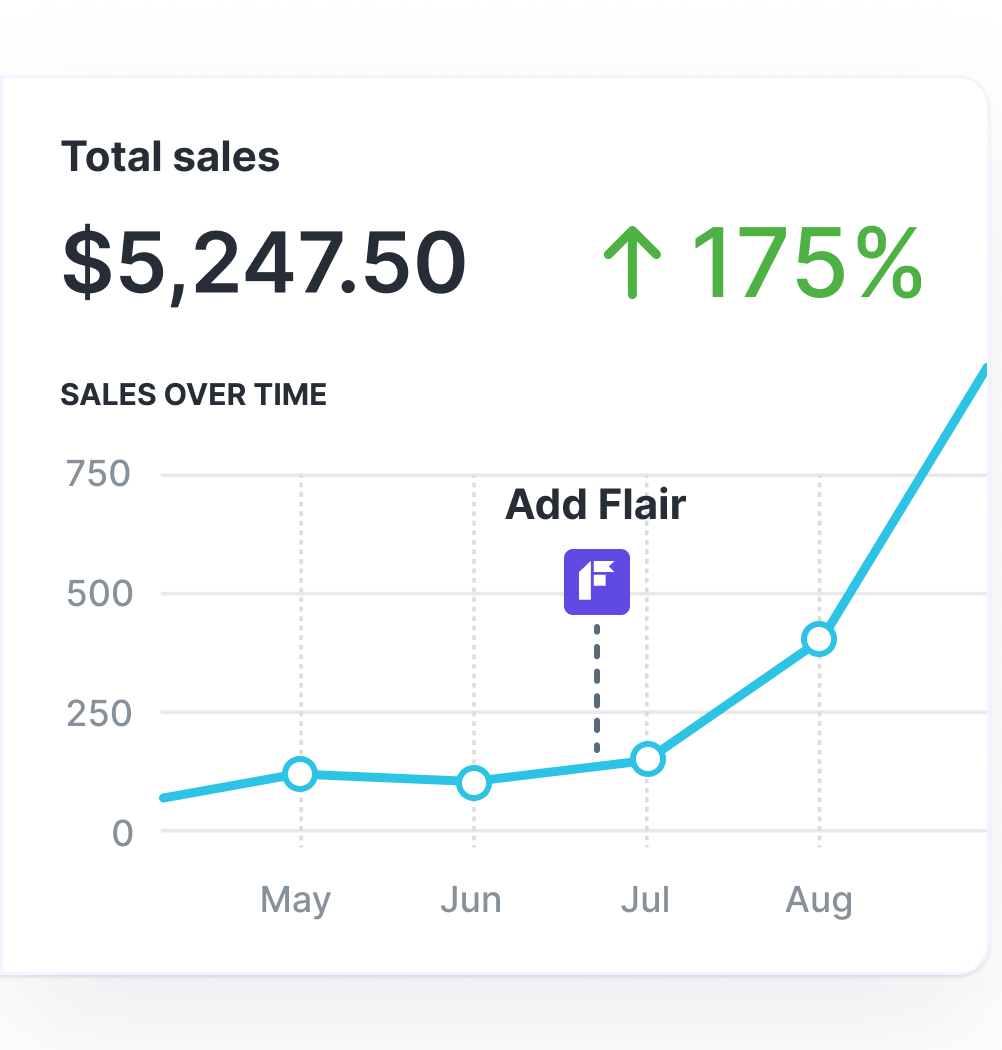Shopify vs Stripe: Features, Pricing & Use Cases Compared

Shopify and Stripe are two of the world’s most popular e-commerce solutions. But which is right for you?
To help you decide, we produced this detailed comparison, covering:
- Shopify vs Stripe pricing
- Key features
- Pros and cons of both platforms
But first, let’s clarify the difference between Stripe and Shopify…
What's the Difference Between Shopify and Stripe?
Stripe is a dedicated payment processing solution used by 1.3+ million websites worldwide, making it the next most popular option behind the big guns of PayPal and Google Pay.

Shopify, on the other hand, is an all-in-one e-commerce solution for building and running an online store.
Shopify statistics show that the platform is used by 2+ million merchants and over 4.6 million live websites, including 28% of online stores in the US:

In other words, they’re very different tools. So the real comparison is between Stripe and Shopify’s native payment gateway, Shopify Payments. That’s what we’ll be discussing in the rest of this article.
Can I Use Stripe on Shopify?
Stripe is a third-party solution that’s compatible with multiple e-commerce platforms. But there’s no easy way to use it on Shopify – at least, not if you’re based in a country where Shopify Payments is available (more on this later).
That’s because Shopify Payments is actually powered by Stripe, and Shopify makes money from transaction fees every time someone buys using Shopify Payments. So they don’t really want you to use a different payment solution like Stripe.
There are some potential workarounds, such as using automation tools like Albato and Zapier to connect Shopify with Stripe. But that carries an additional cost – plus it can be glitchy at scale.
So the simple answer is: “No, you can’t use Stripe on Shopify.”
As such, choosing between Stripe and Shopify Payments is a non-decision for a lot of Shopify merchants. But there are some scenarios where you’d have to make a choice, such as if:
- You currently use a different e-commerce platform (like Adobe Commerce or BigCommerce) and are thinking of switching to Shopify
- You haven’t yet built your online store and aren’t sure whether to go with Shopify or a different e-commerce platform
With that in mind, let’s get into our in-depth comparison of Stripe and Shopify Payments:
Price Comparison
First up, we’ll look at how much it costs to use Stripe and Shopify Payments.
A couple key points to bear in mind:
- For both platforms, fees vary by location. All information in the below table is based on US fees.
- The following information isn’t intended to be exhaustive. There may be additional fees for certain countries, transactions, or credit/debit card types.
So before making your decision, we’d strongly advise checking out the dedicated pricing pages for both Stripe and Shopify Payments.
| Fee Type | Stripe | Shopify Payments |
| Monthly Fees | Stripe is free to set up and has zero monthly fees – you just have to pay per transaction. | There are no specific monthly fees for using Shopify Payments, just transaction fees.
But you can’t use Shopify Payments without a Shopify store. This requires an ongoing subscription, ranging from $5 – $2,300+ per month. Learn more about Shopify’s price plans in our guide: How Does Shopify Work & What Is It? Get Started Guide. |
| Payment Processing Fees | Stripe’s payment processing fees vary by country. Here’s a breakdown for the US:
|
Processing fees for Shopify Payments vary by location and Shopify plan. Here’s a breakdown of the most common fees for the US:
|
| Additional Fees | Here are some of the additional fees US merchants may encounter through Stripe:
|
Here are some of the additional fees US merchants may encounter through Shopify Payments:
|
Stripe Overview

Key Features
Accepted Payment Methods
Stripe supports 100+ payment methods. These include…
- Credit and debit cards (e.g. Visa, Mastercard, American Express, Discover, JCB)
- Digital wallets (e.g. Apple Pay, Google Pay, Microsoft Pay)
- ACH debit, ACH credit, and wire transfers
- Buy now, pay later options (e.g. Afterpay and Klarna)
…plus other local and international payment methods.
Implementation Options
To help you offer customers the best possible checkout experience, Stripe offers a range of integration options. These include using:
- Pre-built or custom payment forms
- A dedicated page to accept payments via a shared link
- Pre-built payment integrations with e-commerce platforms like Adobe Commerce and BigCommerce
- Stripe Terminal for in-person payments
Payout Schedule
Stripe payouts can be managed manually or automated. If you choose to automate payouts, they can be scheduled daily, weekly, or monthly via the Stripe dashboard.
Pros
Customizable Branding
Stripe offers a ton of customization options, allowing you to match your payment solution to your store’s branding. For instance, the Stripe dashboard lets you edit:
- Fonts
- Colors
- Shapes
It also allows you to choose how you want to accept payments – such as leveraging a third-party solution or embedding a pre-built checkout form.
All of which means you can create a more seamless payment experience for your customers.
International Reach
Stripe’s reach is extensive, covering 30+ countries and over 135 currencies. Sure, it’s not exactly global, but it certainly spans all the major e-commerce markets.
Transparent Pricing
As you can see from our Stripe vs Shopify Payments price comparison table, figuring out pricing for different payment solutions can be tricky, with various fees involved.
However, to Stripe’s credit, their payment page is pretty transparent and does a good job of explaining all the different fees affecting your local market. This includes optional extras like automated tax calculation and fraud protection.
Always-On Customer Support
Stripe offers 24/7 support via phone, live chat, and email – with email support available in six languages. You can also reach out to their technical team through the dedicated Stripe Developer Discord server.
For fast, self-service support, Stripe has a comprehensive knowledge base and a ton of technical docs, including sample code in 8+ languages.
Supports a Wide Range of Payment Methods
Stripe supports a wide range of payment options beyond credit and debit cards, from bank payments to buy now, pay later. This is a big deal given that a lack of payment methods is one of the most common reasons for online cart abandonments:

In other words, offering more payment methods can help to increase your e-commerce conversion rate.
Cons
Lack of Shopify Functionality
Arguably the biggest issue with Stripe is that it doesn’t naturally integrate with Shopify in markets where Shopify Payments is available.
Given that Shopify is the world’s biggest e-commerce platform, and that up to 90% of Shopify merchants use Shopify Payments, this massively limits the number of stores that can use Stripe.
Challenging Interface
Stripe focuses on developer-friendly tools like APIs.
This is a big plus for tech-savvy retailers, opening up a whole world of customization options.
But it can be a little daunting for anyone less technically minded. If coding isn’t your thing (and you don’t have a dev team to lean on), you may struggle to make the most of Stripe.
In which case a simpler option – like Shopify Payments – could be a better fit.
Shopify Payments Overview

Key Features
Accepted Payment Methods
Shopify doesn’t give a number for how many payment methods it supports, but it includes…
- PayPal
- Debit and credit cards (e.g. Visa, Mastercard, American Express, JCB)
- Buy now, pay later options (e.g. Shop Pay Installments, Klarna)
- Digital wallets (e.g. Apple Pay, Facebook Pay, Google Pay)
- Manual payment methods (e.g. cash on delivery, bank transfer)
…plus various other local and international payment methods.
However, it’s worth noting that Shopify doesn’t actually process manual payments itself. So if you accept a bank transfer, you’ll need to work with your bank – or a third-party provider – to process the payment.
Implementation Options
There are various ways to accept customer payments using Shopify Payments. For instance, you can:
- Use the built-in checkout system on your Shopify store
- Accept payments through online sales channels like Facebook and Instagram
- Take in-person payments via a Shopify card reader
Payout Schedule
Generally speaking, with Shopify Payments, you can choose daily, weekly, or monthly payouts, with no extra charges for switching from one schedule to another.
However, there are some location-specific differences. For instance, daily payments aren’t available in Japan, while merchants in France can’t choose their own payout schedule.
For more detailed information on scheduling payouts through Shopify Payments, check out Shopify’s Help Center.
Pros
Integrates With Shopify
Stripe’s biggest weakness is Shopify’s biggest plus point.
In available markets, Shopify Payments is automatically included with all Shopify subscriptions at no extra cost (other than transaction fees).
That means you can start accepting customer payments the second your Shopify store goes live.
24/7 Customer Support
Merchants on the Basic and Shopify plans get 24/7 live chat support, while Shopify Advanced subscribers get “enhanced” chat support. Shopify Plus stores can also access 24/7 priority phone support.
Beyond this, Shopify has an extensive Help Center, with articles in 18 languages.
Simple Setup
Because Shopify Payments is built into the Shopify ecosystem, it’s super easy to set up – just head to the Payments section of your Shopify dashboard, click Complete account setup, and fill in the required information.
(Bear in mind Shopify asks for different information depending on where your store is based.)
You can complete the whole process in minutes.
Transparent Pricing
Shopify Payments pricing is a little more complex than Stripe’s because you’ve got to factor in the cost of your monthly Shopify subscription – and because higher-tier Shopify plans charge lower transaction fees.
Still, Shopify’s pricing page is pretty transparent. Our only complaint is that they don’t publish specific card transaction rates for Shopify Plus merchants.
Cons
Limited Availability
The biggest issue with Shopify Payments is its limited coverage. Not only do you have to be a Shopify merchant to use it, but it’s only available in 23 countries:
| Region | Locations where Shopify Payments is available |
| North America | Canada
US |
| Europe | Austria
Belgium Czechia Denmark Finland France Germany Ireland Italy The Netherlands Portugal Romania Spain Sweden Switzerland UK |
| Asia-Pacific | Australia
Hong Kong SAR Japan New Zealand Singapore |
For many locations that aren’t on this list, you can still run a Shopify store – but you can’t use Shopify Payments. So you’ll have to choose a different payment solution (like Stripe or PayPal).
Limited Payout Currencies
As well as having limited coverage, Shopify Payments only supports payouts in 18 currencies – and many aren’t available in certain markets. For instance, US merchants can only get paid in US dollars.
You can find a full list of supported payout currencies (and where they’re available) in the Shopify Help Center.
Penalties for Using Different Payment Providers
Sure, setting up Shopify Payments is a breeze.
But if it’s not available in your location, or if you’d simply prefer to use a different payment solution, Shopify charges an additional 0.5% fee above and beyond what you already pay to your chosen payment provider.
This feels pretty unfair if you’re not in a location served by Shopify Payments.
Which Should You Choose?
When it comes down to it, the choice is pretty simple.
If you’re already a Shopify merchant – or you’re planning to start selling on Shopify – and you’re in one of those 23 eligible countries, Shopify Payments is the obvious option. It’s quick to set up, it integrates seamlessly with your store, and the fees are similar to Stripe (or even cheaper if you’re on a higher-tier Shopify plan).
On the flip side, if you can’t use Shopify Payments for whatever reason, Stripe is an excellent alternative.
FAQs
Do I need Stripe if I have Shopify Payments?
No. Shopify Payments is a dedicated payment gateway within the Shopify platform, and you don’t need Stripe to use it. In fact, if you have Shopify Payments, you can’t use Stripe at all (unless you set up a third-party integration).
Are Shopify Payments and Stripe the same?
No. Shopify Payments and Stripe are both payment gateways, but they’re separate products. However, Shopify Payments is powered by Stripe, so they’re based on the same technology.
Is it possible to use Shopify Payments on Amazon?
No. You can’t use Shopify Payments directly on Amazon – you can only use it for processing transactions on your Shopify store (or in-person using Shopify POS).

Grow Your Shopify Sales by over 175% with Flair
-
Increase sales using product badges and sales banners
-
Maximize conversions with scarcity, urgency and countdown timers
-
Automate promotions with targeted rules and scheduling




